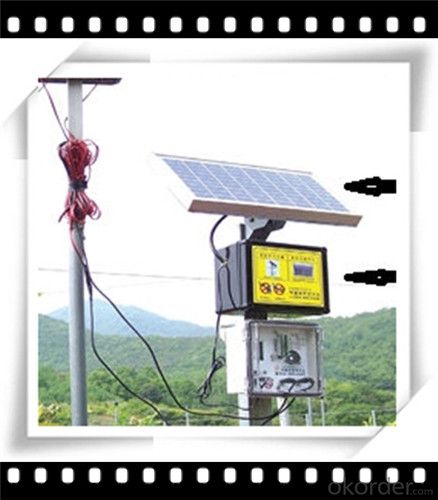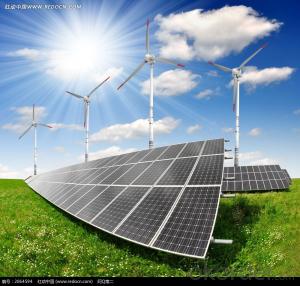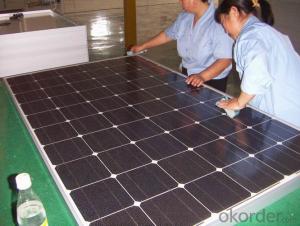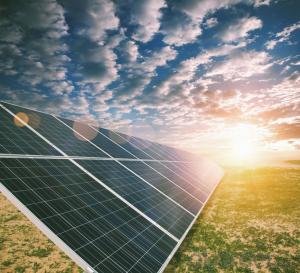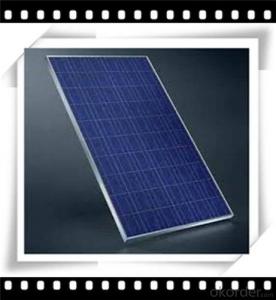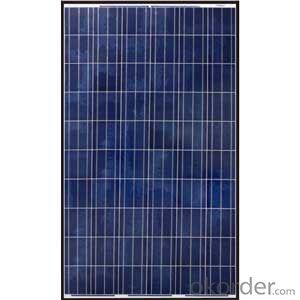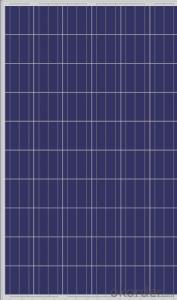245w Poly Solar Panel Medium Solar Panels At Home Depot CNBM China Manufacturer
- Loading Port:
- Qingdao
- Payment Terms:
- TT OR LC
- Min Order Qty:
- 10 set
- Supply Capability:
- 300000 set/month
OKorder Service Pledge
OKorder Financial Service
You Might Also Like
Polycrystalline Solar Modules
CNBM offers a range of small, medium and large polycrystalline solar modules, designed for a range of requirements.

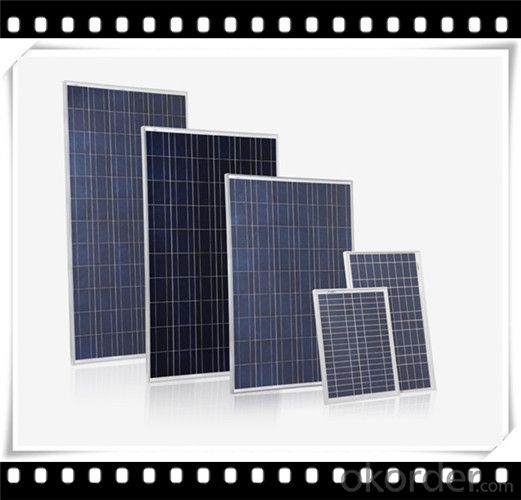
Specifications:
Tolerance | +/-3% |
Cell | Polycrystalline silicon solar cells (156 x 156mm) |
N0. of Cells | 60 (10 x 6) |
Dimension of Modules (mm) | 1650 x 990 x 40 |
Weight (kg) | 25.5 |
Limits:
Operating Temperature | -40~+85? |
Storage Temperature | -40~+85? |
Maximum System Voltage | 1000 VDC max. |
Hail Impact | Diameter of 28mm with impact speed |
Temperature and Coefficients:
NOCT | 48C+/-2? |
Voltage temperature coefficient (%/K) | -0.35 |
Current temperature coefficient (%/K) | 0.05 |
Power temperature coefficient (%/K) | -0.45 |
Characteristics:
Model: | SGM-200P | SGM-210P | SGM-220P |
Max-power voltage Vmp (V) | 29.2 | 29.4 | 29.41 |
Max-power current Imp (A) | 6.85 | 7.14 | 7.48 |
Open-circuit voltage Voc (V) | 36.5 | 36.69 | 36.9 |
Short-Circuit Current Isc (A) | 7.28 | 7.6 | 7.93 |
Max-power Pm(W) | 200 | 210 | 220 |
Model: | SGM-230P |
Max-power voltage Vmp (V) | 29.8 |
Max-power current Imp (A) | 7.72 |
Open-circuit voltage Voc (V) | 37.31 |
Short-Circuit Current Isc (A) | 8.19 |
Max-power Pm(W) | 230 |
STC: Irradiance 1000W/m2, module temperature 25?, AM-=1.5
Poly Crystalline Solar Panels Specifications Range
Maximum Power (Pm) | Dimension | Weight | Operating Voltage (Vmp) | Operating Current (Imp) | Open Circuit Voltage (Voc) | Short Circuit Current (Isc) |
0.45W | 140x80x10mm | 0.08kg | 3.3V | 150mA | 4.6V | 160mA |
1.0W | 162x140x10mm | 0.16kg | 7.5V | 150mA | 10.3V | 160mA |
4.5W | 269x251x23mm | 0.8kg | 16.5V | 0.27A | 20.5V | 0.3A |
10W | 420.1×268.9×22.6mm | 1.92kg | 17.5V | 0.58A | 20.5V | 0.6A |
20W | 425x502x50mm | 3.0kg | 16.8V | 1.19A | 21.0V | 1.29A |
30W | 593x502x22.6mm | 3.9kg | 16.8V | 1.78A | 21.0V | 1.94A |
40W | 655x537x50mm | 5.75kg | 17.3V | 2.31A | 22.1V | 2.54A |
50W | 839x537x50mm | 6.0kg | 17.5V | 2.9A | 21.8V | 3.17A |
65W | 1111x502x50mm | 7.2kg | 17.6V | 3.69A | 22.1V | 3.99A |
80W | 1204x537x50mm | 7.7kg | 17.6V | 4.55A | 22.1V | 4.8A |
- Q: How long does it take to recoup the investment in solar panels?
- The time it takes to recoup the investment in solar panels varies depending on several factors such as the cost of the panels, installation expenses, local energy rates, and available incentives. On average, it typically takes around 6 to 10 years to recoup the initial investment. However, with decreasing panel costs and increasing energy savings, the payback period is continually improving, making solar panels a worthwhile long-term investment for many homeowners and businesses.
- Q: I had someone quote me for solar panels on my house but I can't afford it. They were talking about how I have enough room and the perfect location to put many of them and actually get paid for it. I have about a half acre that is tiered and points in the correct direction for them to get pretty much the full day sun. Additionally, I live in so cal where it is sunny most of the year. Does anyone know if solar companies will lease or install them to get the payback? I would be happy to allow them to use the land just to cover my electrical expense and they could have any payback.
- There okorder /... The article below gives some other creative ways to finance a PV system.
- Q: Are there any safety concerns with solar panels?
- Yes, there are some safety concerns with solar panels, although they are generally considered safe. The main concerns include the risk of electrical shock or fire due to improper installation or maintenance, potential harm from falling panels or debris during severe weather events, and exposure to toxic materials used in panel manufacturing. However, these risks can be minimized through proper installation, regular maintenance, and adherence to safety guidelines and regulations.
- Q: I need a solar panel which can light up 4 full loaded 5 rooms appartment houses
- good idea going solar, i would suggest doing a google search, as their are many suppliers. then you need to calculate the amount of wattage you think these apartment houses are going to require. volts x amps = watts. if you are going to be off of the power grid, then you will need a way to store excess energy during good times,( lots of sun) in order to use it during bad times ( no sun ). or see if you are able to sell your extra power back to your local power company, check because some companies do not allow this. you could even have a generator for emergencies if you go off the power grid. on final note, solar is a pretty sizable investment up front and your profits are seen mainly in the long run, but you will get energy savings immediately, but more likely those savings will go to paying off the solar panels also, you will need a converter to convert the ac (alternate current) produced by the panels into dc ( direct current ) which is used by the apartments. it will tie in to the existing electrical system in the apartments. i know germany is really pushing solar energy and they offer their citizens some pretty sweet deals to go solar. the companies are profiting from this so i would suggest looking for a supplier in germany, first. they may have better deals, or try bp (british petroeum) they have been in the solar business for awhile. i wish you success!
- Q: Can solar panels be installed in urban areas?
- Yes, solar panels can be installed in urban areas. In fact, they are increasingly being installed on rooftops, facades, and even integrated into buildings in cities around the world. Urban areas offer ample opportunities for solar panel installation, promoting clean energy generation and reducing dependence on fossil fuels.
- Q: Can solar panels be installed on a hotel or hospitality facility?
- Yes, solar panels can be installed on a hotel or hospitality facility. In fact, many hotels and hospitality facilities are adopting solar energy as a sustainable and cost-effective solution. Solar panels can be installed on the rooftops, parking lots, or any available open space to generate clean and renewable energy for the facility's electricity needs. This not only reduces the carbon footprint but also helps in saving on energy bills in the long run.
- Q: Can solar panels be used for powering electric boats or marine vessels?
- Yes, solar panels can be used to power electric boats or marine vessels. Solar panels are a sustainable and efficient source of energy that can be used to charge the batteries of electric boats, providing a clean and renewable power source for propulsion. This helps reduce dependence on fossil fuels and minimizes the environmental impact of marine transportation.
- Q: I was just wondering what the minimum and maximm charging voltage and ampere is for li ion batteries. If i connect a solar panel, which only gets enough sunshine to generate voltage, will that still charge the battery, or would i have to series connect solar panels until they together reach 3,7volt?
- One lithium cell requires 4.2V to obtain its full charge, Never exceed 4.2V ! Output from solar panel if below 3.7V , nothing charge to lithium. Total charging time until the cell is full depending on the AH rate of cell and the charging current that solar panel can be provided. Suppose cell is rate 5AH, and the charging current from solar panel under full sun shine can maintain 0.5A ( use solar panel short circuit current rate from its specification as a reference ) , hence, 0 hours is enough. And be sure the solar panel can maintain 4.2V output at 0.5A . Remember, over charge lithium cell one time might reduce its life into half . Therefore, let the solar panel output passing through a precision regulator to maintain output is 4.2V is the best way, because, as cell reaches 4.2V , no more charging current is forced into cell ( automatic stop charging ). If you do not have the knowledge to make this simple variable voltage regulator with LM37K ( if you choose this way, buy solar panel output has at least 2V) , you may choose to do it manually by install a current meter and a variable resistor in series between the panel output to cell. By adjust the value of resistor, charging current can be controlled ( if you choose this way, buy solar panel output has as less as 6V ). Count the charging time with a clock and adjust the charging current from time to time to maintain 0.5A .
- Q: Can solar panels be installed on mobile homes?
- Yes, solar panels can be installed on mobile homes.
- Q: How much does 000 square feet of solar panels cost? This is for a pool with dimensions 75ft by 25ft? How much will it cost including installation fee and the water heater?
- My Father-in-Law had around 300sqft of solar panels installed for the equivalent of around ?3000 or $5000. These were just the cheap and relatively inefficient black plastic tubes that were installed on his roof. This was in South Africa where the labour rates are quite cheap. The system works okay and heats a 40ft x 20ft outdoor pool to over 30C in the height of summer. Rather than a pool heater, I think it might be good to look at an air source heat pump to help heat the water in Autumn/Winter when you don't get enough sun to heat the pool. These will be expensive (over $5000), but they will use less than 30% of the electricity of a standard electric water heater. Just the solar panels could cost you $5-20K including fitting.
Send your message to us
245w Poly Solar Panel Medium Solar Panels At Home Depot CNBM China Manufacturer
- Loading Port:
- Qingdao
- Payment Terms:
- TT OR LC
- Min Order Qty:
- 10 set
- Supply Capability:
- 300000 set/month
OKorder Service Pledge
OKorder Financial Service
Similar products
Hot products
Hot Searches



